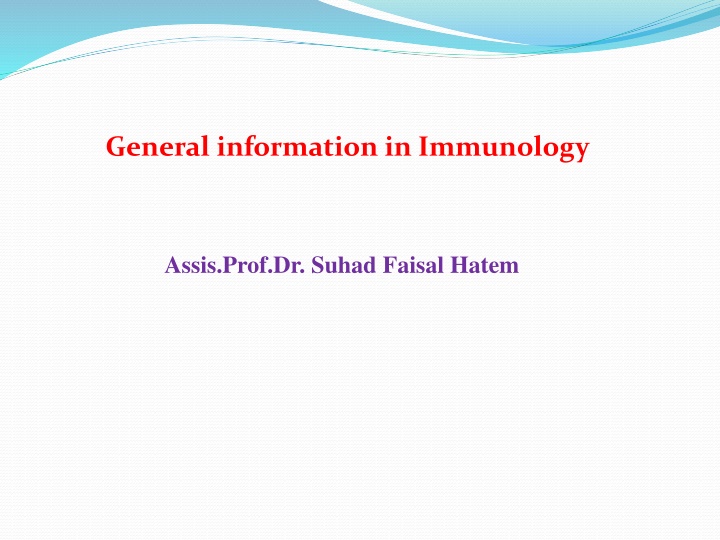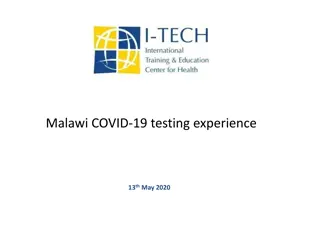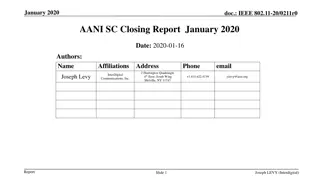
Immunology: Host's Immune Responses to Foreign Substances
Learn about immunology and the immune system's response to foreign substances, including the role of antibodies, antigens, and different immune cells like monocytes and granulocytes. Explore how the immune system develops and functions to protect the body from pathogens.
Download Presentation

Please find below an Image/Link to download the presentation.
The content on the website is provided AS IS for your information and personal use only. It may not be sold, licensed, or shared on other websites without obtaining consent from the author. If you encounter any issues during the download, it is possible that the publisher has removed the file from their server.
You are allowed to download the files provided on this website for personal or commercial use, subject to the condition that they are used lawfully. All files are the property of their respective owners.
The content on the website is provided AS IS for your information and personal use only. It may not be sold, licensed, or shared on other websites without obtaining consent from the author.
E N D
Presentation Transcript
General information in Immunology Assis.Prof.Dr. Suhad Faisal Hatem
Immunology study of a hosts reactions when foreign substances are introduced into the body. Immune response As the immune system defends the host against pathogens, it uses different recognition systems to effectively eliminate the invading pathogen or its products. A response generated against a potential pathogen is called an immune response. Antigen A foreign substance that induces such an immune response is called an antigen. Antigen that causes immune response termed immunogen. Antigens have specific sites that bind to antibodies called epitope . Proteins and polysaccharides induce strong response while Lipids and nucleic acids often less than.
Antibody : A protein OR substance that is produced in immune response against a particular pathogen(antigen) Bind to antigens and identify the antigen complex for destruction. Antibodies act on antigens in the serum and lymph. B-cell produced antibodies (immunoglobulin) The Immune System Immune system identifies antigens (foreign proteins or polysaccharides) Human immune system begins to develop in the embryo. Starts with hematopoietic (from Greek, "blood-making") stem cells. Stem cells differentiate into major cells in the immune system Myeloid stem cell consist : granulocytes, monocytes, megakaryocyte, erythrocytes. lymphoid stem cell consist : T-cells ,B-cells , NK cells Stem cells continue to be produced and differentiate throughout ones lifetime.
1-Monocytes :are small leukocytes that circulate in the blood and mature into macrophages that can be found in almost all tissues. They are known as ( Kupffer cells in the liver , Microglial cells in the nervous tissue, Alveolar cells in lung). Action of Macrophages engulf and kill pathogens enters the body through the lymphatics, lung, or blood stream. process and present antigen to T lymphocytes regulate immune reactivity by producing a variety of molecules (eg, cytokines). 2- Granulocytes are leukocytes that contain densely staining granules, include: Neutrophils (60%) have a short half-life and are important phagocytic cells that destroy pathogens within intracellular vesicles. Eosinophils (1-3%)are less abundant and store granules containing enzymes and toxic proteins that can be released upon activation of the cells. Act in allergic and parasite infection. Basophils (1%) it is important in hypersensitivity madiater which activate the histamine realese causing allergy.
A white blood cell engulfs a microbe, then fuses with a lysosome to destroy the microbe.There are different types of phagocytic cells Neutrophils engulf and destroy pathogens Macrophages are found throughout the body Dendritic cells stimulate development of adaptive immunity Eosinophils discharge destructive enzymes
PHAGOCYTIC CELL Lysosome containing enzymes Vacuole
3-Lymphocyte (30%) Have two type called T cells & B cells A-T cells :have a specific receptor for a fragment of antigen 1-Cytotoxic T-cells: Contain a surface protein called CD8 Destroy pathogen infected cells,cancer cells, and foreign cells (transplanted organs) 2-Helper T-cells: Contain a surface protein called CD4 Regulate both cellular and humoral immune systems
B lymphocyte B-cell produced antibodies ,these antibodies may be attached to B-cell membranes or Free in the serum and lymph. Each B lymphocyte makes a unique antibody molecule (immunoglobulin or Ig) . Natural Killer Cells Natural killer (NK) cells are large, granular lymphocytes ,morphologically related to T cells, which make up 10 15% of blood leukocytes. Action of NK NK cells have the ability to recognize and kill virus-infected cells and tumor cells. NK cells contain large amounts of granzyme and perforin, substances that mediate the cytotoxic actions . NK cells are one of the two primary sources of IFN- , a potent antiviral and immunoregulating cytokine. No antigen receptors Recognize antigens by means of Fc portion of IgG antibodies and kill the cell.
Primary lymphoid organs: Bone marrow and thymus are primary lymphoid organs Location where stem cells destined to become B and T cells mature B cells mature in bone marrow T cells mature in thymus Once mature, cells leave primary lymphoid organs and migrate to secondary lymphoid organs. Secondary lymphoid organs: Sites where lymphocytes gather to fight the antigens; organs include: Lymph nodes ,Spleen, Tonsils, Adenoids, Appendix,Perye patch. Lymphatic vessels : Carry lymph to body tissues ,Lymph travels through vessels to lymph nodes. Material such as protein is removed
the main function of the immune system is to prevent or limit infections, bacteria fungi, and parasites, such as protozoa and worms. The first line of defense Firstly,Barriersskin , mucous membranes,Enzymes ..etc. If microorganisms breach this line and enter the body, then the innate immunity is available to destroy the invaders. Because the components of the innate immunity are preformed and fully active, they can act immediately upon entry of the microorganisms. The ability of the innate immunity to kill microorganisms is not specific. For example, a neutrophil can ingest and destroy many different kinds of bacteria. Second line of defense Highly specific protection is provided by the adaptive (acquired) immunity, it takes several days to become fully functional. The two components of the adaptive immunity are 1-cell-mediated immunity 2-antibody-mediated (humoral) immunity.














